I’ve put together a list of the five most popular CCTV camera types for UK homes: Wireless Security Cameras, Wired CCTV Cameras, Video Doorbell Cameras, Dome Cameras, and Bullet Cameras. These are the ones you’ll find in lots of homes across the UK. I obtained this information by examining what’s selling well in UK stores, analyzing online feedback, and reviewing security trends up to August 2025. I picked these cameras because they’re affordable, easy to use, and have cool features like phone alerts or night vision that make them great for keeping your home safe.
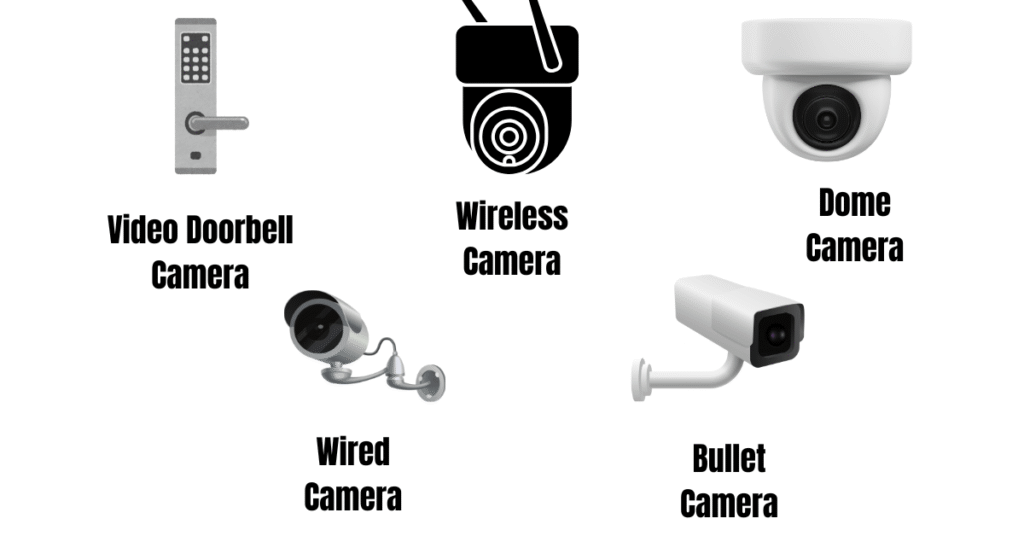
Which one do people love most? Video doorbell cameras (like Ring or Google Nest) are the top choice, used by about 20-30% of UK homeowners. They’re popular because they’re simple to set up and let you see or talk to visitors from your phone. Wireless security cameras (like Eufy or TP-Link) are next, used by around 30-40%, since they’re easy to place anywhere without messy wires. Wired CCTV cameras (like Hikvision or Reolink) are used by about 20-25%, great for people who want a system that’s always on. Dome cameras and bullet cameras each cover around 10-15%, with domes being quiet and subtle for indoor spots or porches, and bullets being bold for gardens or driveways.When you think about UK-based security cameras, you will need to understand the calculation of security installation and equipment costs..Let’s explore the 5 key things you should know about these security cameras.

These percentages are estimates because not everyone registers their cameras, but they’re based on what’s popular in sales and online talks.you need when you buy Se In this blog, I’ll explain each camera type to help you choose the best one for your home!
Did you know about the top UK-based home security brands?
Why Video Doorbell Cameras Are a UK Home Security Favorite
Video doorbell cameras are a top pick for UK homeowners, and it’s easy to see why. They’re simple, smart, and keep your front door secure. Here’s a quick look at where they’re used, how to position them, their coverage, internet needs, storage, setup, pros, cons, and who they’re best for.
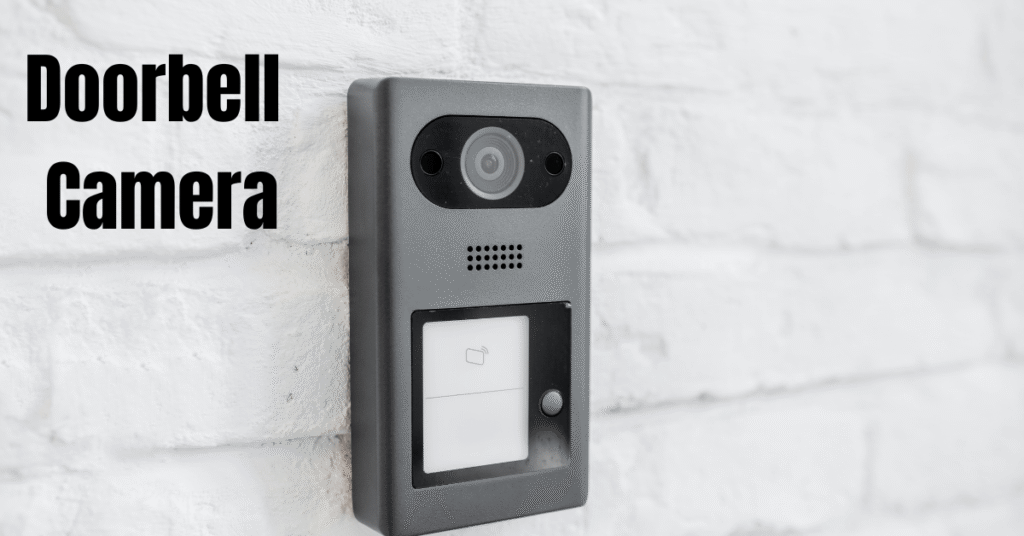
Where They’re Used and Best Position
Video doorbell cameras are mostly used at front doors to watch visitors, delivery drivers, or potential intruders. They’re perfect for catching package thieves or checking who’s knocking. For the best results, mount them at 1.2 meters (4 feet) high, at eye level, to capture clear faces and a full view of anyone approaching. Use a wedge or corner kit if your door has stairs or angled siding to adjust the angle for a better view. Avoid placing them too high or low to prevent missing key details or getting false motion alerts.
Doorbell Cameras Coverage, Internet, and Storage
These cameras typically cover a wide-angle view of 130-160 degrees, enough to see your porch and part of the pathway, usually up to 5-10 meters. They need a stable Wi-Fi connection to send live video and alerts to your phone. Without internet, they can’t stream or notify you, but some models store footage locally. Storage is either cloud-based (often with a subscription, like Ring’s £3-£8/month plan) or local (via microSD, like Eufy). Cloud storage is safer but costs more; local storage is cheaper but risks data loss if the device is stolen,Cloud storage vs local storage.
Doorbell Cameras Set up, Pros, and Cons
Most video doorbells are DIY-friendly, with simple instructions and apps to guide you. Battery-powered models (like Ring Battery Doorbell) are easiest, while wired ones (like Google Nest Wired) might need basic electrical know-how. Advantages: Easy to install, smartphone alerts, two-way talk, and strong deterrence. Disadvantages: Limited view compared to wider cameras, subscription costs for full features, and Wi-Fi dependency. UK Note: You must follow GDPR laws, avoiding recording neighbors’ properties without consent.
Who They’re Best For
Video doorbells suit busy homeowners, renters, or families who want simple security and remote monitoring. They’re ideal for urban homes with frequent visitors or deliveries.
Important Info: Check local Wi-Fi strength before buying, as weak signals can disrupt performance. In the UK, visible cameras can reduce burglary risk by up to 300%, according to studies.
Wireless Security Cameras: Flexible Protection for UK Homes
Wireless security cameras are a favorite for UK homeowners who want easy, versatile home security. They’re simple to set up and work almost anywhere, making them a top pick. Let’s look at where they’re used, how to position them, their coverage, internet needs, storage options, setup, pros, cons, and who they’re best for.

Where They’re Used and Best Placement for Wireless Security Cameras
Wireless security cameras are perfect for gardens, driveways, backyards, or indoor spots like living rooms or hallways. They’re great for keeping an eye on kids, pets, or potential intruders. For the best results, place them 2-3 meters high (6-10 feet), angled to cover key areas like doors or gates. Mount them under eaves or on walls for outdoor use to protect from rain. Avoid pointing them directly at bright lights or busy roads to prevent false motion alerts.
Wireless Security Cameras Coverage, Internet, and Storage
These cameras typically offer a 90-140 degree field of view, covering 10-15 meters depending on the model (like Eufy SoloCam or TP-Link Tapo). They need Wi-Fi to stream live video and send alerts to your phone. Without internet, they can still record if they have local storage, but you won’t get real-time updates. Storage options include cloud subscriptions (like Arlo’s £3-£10/month plans) or local microSD cards (common in Eufy or Blink). Cloud storage is secure but costs extra; local storage is budget-friendly but risks data loss if the camera is tampered with. Cloud storage vs local storage.
Setup, Pros, Cons, and Ideal Users
Most wireless cameras are DIY-friendly, with apps guiding you through setup in minutes. Battery-powered models (like Blink Outdoor) need no wiring, while some require a power outlet. Pros: Easy to install, flexible placement, phone alerts, and night vision. Cons: Depend on Wi-Fi, batteries need recharging, and subscriptions can add up. They’re ideal for renters, small homeowners, or tech-savvy users who want flexible, no-fuss security.
Key Info: Check your Wi-Fi range, as weak signals can disrupt performance. UK laws (GDPR) require avoiding recording public spaces or neighbors’ property without consent. Studies show visible cameras can reduce break-ins by up to 300%.
Wired CCTV Cameras: Reliable Security for UK Homes
Wired CCTV cameras are a solid choice for UK homeowners who want dependable, no-nonsense home security. They’re built to last and offer constant monitoring, making them a go-to for many. Let’s cover where they’re used, how to position them, their coverage, internet needs, storage options, setup, pros, cons, and who they’re best for.
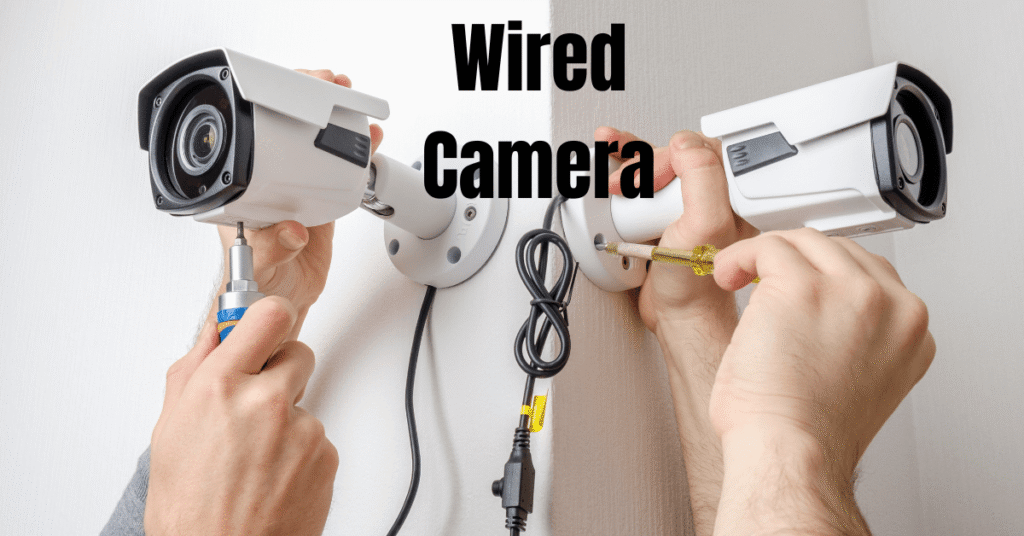
Where Wired CCTV is Used and Best Placement
Wired CCTV cameras are commonly used for outdoor perimeters, driveways, or large properties, perfect for monitoring big areas like gardens or parking spaces. They’re also great for shops or home offices. For the best view, mount them 2.5-4 meters high (8-13 feet) on walls or under eaves to cover entry points like gates or doors. Angle them to avoid glare from lights or the sun, and ensure cables are hidden to prevent tampering.
Wired CCTV Coverage, Internet, and Storage
These cameras typically have a 90-120 degree field of view, covering 10-20 meters depending on the lens (like Hikvision or Reolink models). They don’t always need internet for recording, as they often connect to a DVR or NVR for local storage, but Wi-Fi enables remote viewing on your phone. Storage is usually local on a DVR/NVR hard drive (1-4TB, lasting weeks or months), but some systems offer cloud backup for extra cost. Local storage is reliable but needs regular checks to avoid overwriting old footage.
Wired CCTV Setup, Pros, Cons, and Ideal Users
Setting up wired CCTV often requires professional help due to complex cabling and power needs, though tech-savvy users might manage with PoE systems. Pros: Rock-solid reliability, high-quality footage (up to 4K), and constant recording. Cons: Tricky installation, higher upfront costs, and less flexible placement. They’re best for homeowners with large properties, businesses, or those prioritizing uninterrupted surveillance.
Key Info: In the UK, GDPR rules mean you must avoid recording public spaces or neighbors’ property without permission. Visible cameras can cut burglary risk by up to 300%, per UK studies. Regular maintenance, like cleaning lenses, ensures clear footage.
Dome Cameras: Your Sneaky Security Sidekick for UK Homes
Dome security cameras are like the ninjas of home security—quiet, discreet, and super effective. UK homeowners love them for their ability to blend in while keeping watch. Let’s break down where they work best, how to set them up, what they cover, internet and storage details, setup ease, benefits, drawbacks, and who they’re perfect for.
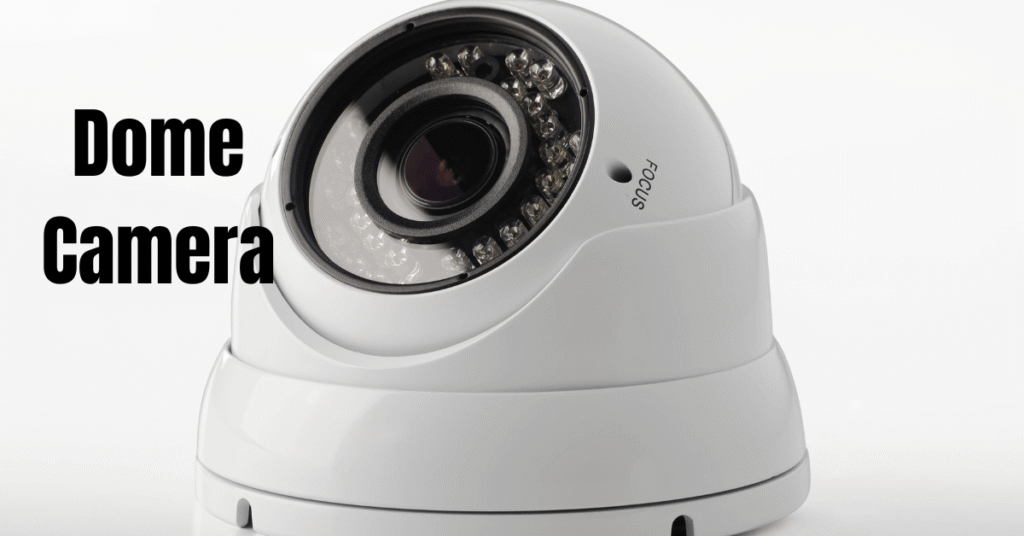
Where Dome Cameras Fit and How to Place Them
You’ll often spot dome cameras in cozy indoor spots like living rooms, kitchens, or hallways, or sheltered outdoor areas like porches or carports. They’re great for quietly monitoring kids, pets, or sneaky intruders. Pop them 2-3 meters up (6-10 feet) on a ceiling or wall, angled toward doors or open areas for a clear view. Their dome shape hides where they’re pointing, which spooks potential troublemakers. Keep them away from bright lights or cluttered corners to avoid blurry or blocked footage.
Dome Cameras Coverage, Internet, and Storage Scoop
These cameras usually cover a 90-120 degree angle, watching over 8-15 meters—think a porch or medium-sized room (like Hikvision or Reolink domes). They don’t need internet to record if hooked to a DVR or NVR, but Wi-Fi lets you check footage on your phone. Storage is mostly local on a DVR/NVR (1-4TB holds weeks of video), though some offer cloud options for a monthly fee. Local saves money but needs checking to avoid overwriting; cloud is safer but pricier.
Dome Cameras Setup, Benefits, Drawbacks, and Best Users
Wiring makes dome cameras tricky to install for most, so pros are often needed, though PoE models are a bit easier for DIY fans. Benefits: They’re tough to tamper with, blend in nicely, and deliver sharp footage. Drawbacks: Less flexible lenses, not as bold a deterrent, and setup costs can add up. They’re great for homeowners or small shops wanting subtle, reliable security.
Must-Know: UK GDPR laws say don’t record neighbors or public spaces without permission. Clean lenses regularly for clear views. Studies suggest cameras like these can slash burglary risks by up to 300%.
Bullet Security Cameras: Bold Guardians for UK Homes
Bullet security cameras are a top pick for UK homeowners who want strong, visible protection. Their sleek, tube-like design screams “stay away” to intruders while keeping your property safe. Let’s dive into where they shine, how to position them, their coverage, internet needs, storage options, setup, benefits, drawbacks, and who they’re perfect for.
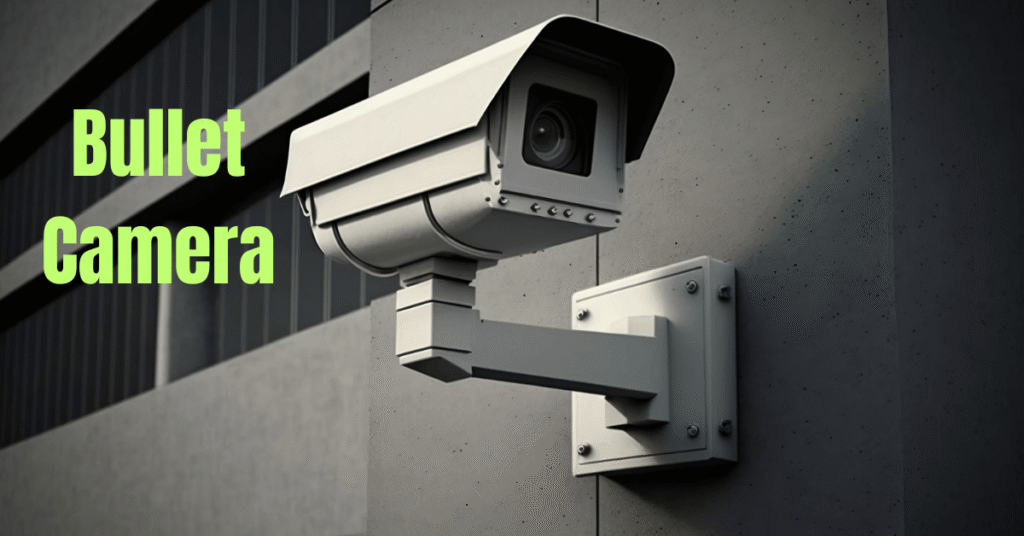
Where Bullet Cameras Work Best and How to Place Them
Bullet cameras are ideal for outdoor areas like driveways, gardens, or backyards, where they keep watch over large spaces or deter break-ins. They’re also great for garages or side entrances. Mount them 2.5-4 meters high (8-13 feet) on walls or under eaves, angled to cover gates, paths, or vehicles. Their long shape helps focus on distant spots, but avoid aiming them at bright lights or busy streets to prevent false alerts or washed-out footage.
Bullet Cameras Coverage, Internet, and Storage Basics
These cameras typically have a 90-120 degree view, covering 10-20 meters or more, especially with varifocal lenses (like Hikvision or ZOSI models). They don’t need internet to record if connected to a DVR or NVR, but Wi-Fi lets you check live footage on your phone. Storage is usually local on a DVR/NVR hard drive (1-4TB, storing weeks of footage), though some offer cloud options for a fee. Local storage is budget-friendly but needs regular checks to avoid overwriting; cloud storage is secure but adds monthly costs.
Bullet Cameras Setup, Benefits, Drawbacks, and Best Users
Installing bullet cameras often needs a professional due to wiring for power and data, though PoE models are simpler for tech-savvy DIYers. Benefits: Long-range clarity, weatherproof design, and a bold deterrent effect. Drawbacks: They’re noticeable, so less discreet, and setup can be pricey. They’re perfect for homeowners with big properties, rural dwellers, or businesses needing clear, far-reaching surveillance.
Key Info: UK GDPR rules mean you can’t record public spaces or neighbors’ property without consent. Regular lens cleaning keeps footage sharp. UK studies show visible cameras like these can cut burglary risks by up to 300%.
About These 5 Security Cameras
Video Doorbell Cameras (20-30% usage) guard front doors, covering 5-10 meters (130-160° view). Mounted at 1.2m, they need Wi-Fi for streaming and use cloud or microSD storage. Easy DIY setup, great for families or renters, but rely on internet.
Wireless Security Cameras (30-40% usage) watch gardens or indoors, covering 10-15 meters (90-140°). Placed 2-3m high, they need Wi-Fi, with cloud or microSD storage. DIY-friendly and flexible, but battery and Wi-Fi-dependent. Best for small homes or renters.
Wired CCTV Cameras (20-25% usage) secure large properties, covering 10-20 meters (90-120°). Mounted 2.5-4m high, they don’t need internet for DVR/NVR recording. Setup needs pros, ideal for big homes or businesses, but installation is costly.
Dome Cameras (10-15% usage) blend into hallways or porches, covering 8-15 meters (90-120°). Mounted 2-3m high, they use DVR/NVR or cloud storage. Subtle and tamper-proof, but need pro setup. Great for discreet home or shop security.
Bullet Cameras (10-15% usage) protect driveways or gardens, covering 10-20 meters. Placed 2.5-4m high, they’re like domes for storage/internet but deter boldly. Best for large or rural properties, though setup is complex.
Note: Follow UK GDPR to avoid recording public spaces. Visible cameras can cut burglary risk by 300%, according to studies.
